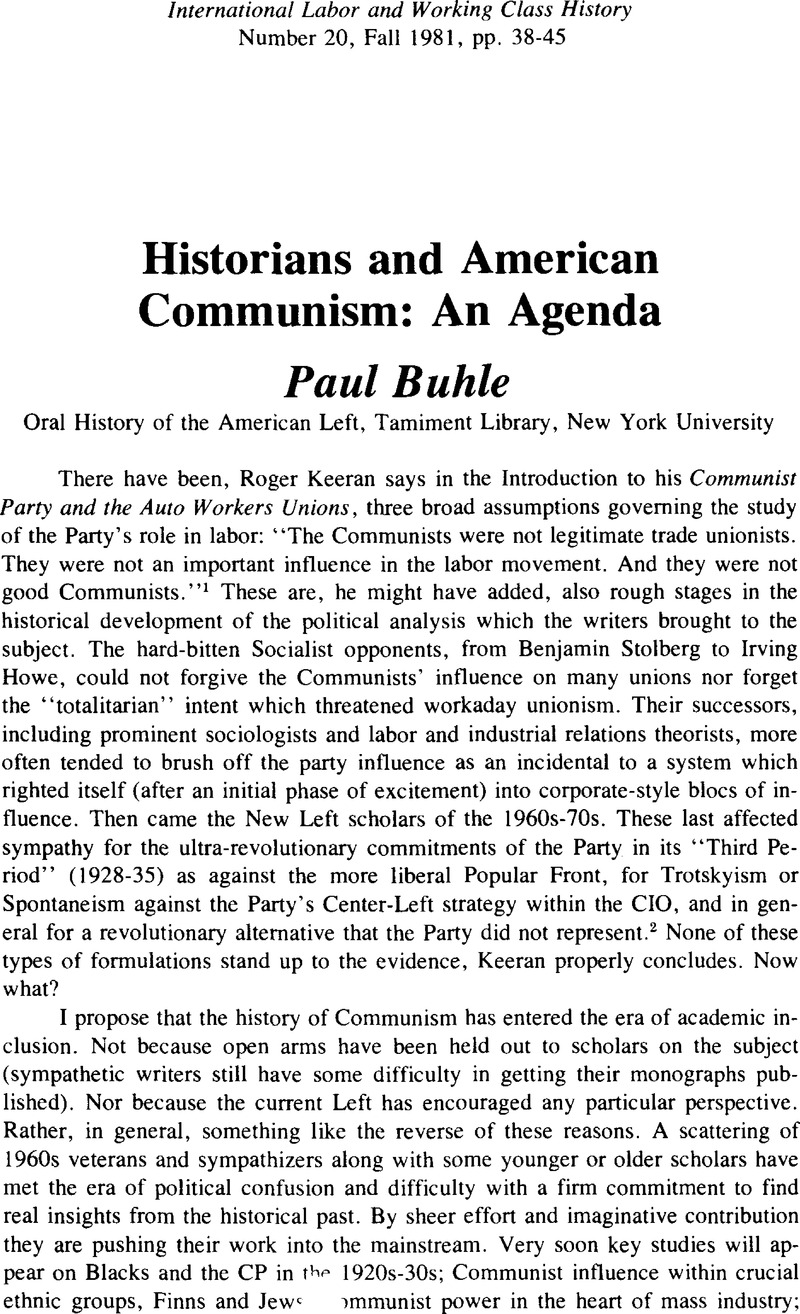Article contents
Historians and American Communism: An Agenda
Published online by Cambridge University Press: 16 December 2008
Abstract

- Type
- Essay
- Information
- Copyright
- Copyright © International Labor and Working-Class History, Inc. 1981
References
NOTES
1. Keeran, Roger, The Communist Party and the Auto Workers Unions (Bloomington, 1980), 24.Google Scholar
2. See for example Stolberg, Benjamin, The Story of the CIO (New York, 1938)Google Scholar or Howe, Irving and Widick, B.J., The UAW and Walter Reuther (New York, 1949)Google Scholar; Derber, Milton and Young, Edwin, eds., Labor and the New Deal (Madison, 1957)Google Scholar is a typical example of the second category; the work of Prickett, James, “The Communists and the Communist Issue in the American Labor Movement, 1920–1950 (Ph.D. dissertation, UCLA, 1975)Google Scholar, and Lichtenstein, Nelson as in “Defending the No-Strike Pledge: CIO Politics During World War II,” Radical America, 9 (07–08, 1975) offer outstanding examples of the third case.Google Scholar
3. A foretaste of this abundance can be seen in Naison, Mark, “Harlem Communists & the Politics of Black Protest,” Marxist Perspectives, I (Fall, 1978)Google Scholar; For the Common Good: Finnish Immigrants and the Radical Response to Industrial America (Superior, Wisconsin, 1978)Google Scholar; and my own “Jews and American Communism: The Cultural Question,” Radical History Review, #23 (Fall, 1980).Google Scholar
4. McKay, Claude, Banjo: A Story Without a Plot (New York, 1929), 272–73.Google Scholar
5. See Schatz, , “Union Pioneers: the Founders of Local Unions at General Electric and Westinghouse, 1933–1937,” Journal of American History, 66 (12, 1979)CrossRefGoogle Scholar; and his “The End of Corporate Liberalism: Class Struggle in the Electrical Manufacturing Industry, 1933–1950,” Radical America, 9 (07–08, 1975).Google Scholar
6. Kami's, work is developed in “Yhteishyri: Or, For the Common Good, Finnish Radicalism in the Western Great Lakes Region, 1900–1940” (Ph.D. dissertation, University of Minnesota, 1975)Google Scholar; Stipanovich's, in “Immigrant Workers and Immigrant Intellectuals in Progressive America: A History of the Jugoslav Socialist Federation, 1900–1918” (Ph.D. dissertation, University of Minnesota, 1978); see my own essay, cited above, on the International Workers Order.Google Scholar
7. Rivkin, B., “Grunt-Tendensten fun der Yiddish Literatur in Amerika,” in a book of the same title (New York, 1948)Google Scholar. The characterization typically describes the untranslated trilogy about American life and the immigrant radical labor movement, Ignatov's, DavidEuf Veite Vegn (New York, 1932).Google Scholar
8. Keeran, ; Klehr, , Communist Cadre, the Social Background of the American Communist Party Elite (Stanford, 1978).Google Scholar
9. For a fuller development of this view by James, C.L.R., see Facing Reality (Detroit, 1974)Google Scholar, The Future in the Present: Selected Writings (Westport, Connecticut, 1977)Google Scholar, and my own essay, in a volume I have edited, “C.L.R. James: American Marxist,” in a special number of the journal Urgent Tasks (Spring, 1981) devoted to James' life and work.Google Scholar
10. Surkin, Marvin, Detroit: I Do Mind Dying (New York, 1975).Google Scholar
11. Isserman, Maurice, “The 1956 Generation: An Alternative Approach to the History of American Communism,” Radical America, 14 (03–04, 1980).Google Scholar
- 1
- Cited by




